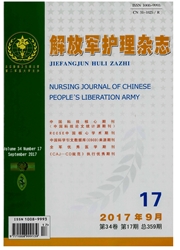

 中文摘要:
中文摘要:
目的探讨带空气穿刺法对B超引导下经外周置入中心静脉导管(peripherally inserted central catheter,PICC)穿刺的影响,以期为临床PICC准备提供参考依据。方法2014年1月至2015年6月,便利抽样法选取在安徽省立医院肿瘤科治疗的266例肿瘤患者为研究对象,所有患者均在B超引导下行PICC。按随机数字表法将其分为观察组和对照组,每组133例。观察组患者采用肝素液预冲穿刺针后弃去肝素液(带空气穿刺法),对照组采用肝素液预冲后穿刺针内保留肝素液(带液穿刺法),比较两组患者的PICC穿刺一次成功率及置管时间。结果观察组患者PICC一次穿刺成功率为92.48%(123/133),高于对照组的84.21%(112/133),差异有统计学意义(P〈0.05)。观察组患者置管所需时间为(19.98±2.12)min,少于对照组的(23.45±2.05)min,差异有统计学意义(P〈0.05)。结论PICC操作中,带空气穿刺法优于带液穿刺法,能提高PICC一次穿刺成功率,缩短穿刺置管时间,值得推广。
 英文摘要:
英文摘要:
Objective To discuss the effect of air puncture method on B-ultrasound guided peripherally inserted central catheter (PICC), in order to provide references for PICC puncture in clinic. Methods By convenience sampling, 266 cases of cancer patients using PICC under ultrasonic guidance in department of oncology were randomly selected and divided into observation group and control group, with 133 cases in each group. The observation group was received heparin solution for pre-rinsing the needle, and then discarded it (with air puncture), while the control group kept the heparin solution within the needle (with liquid puncture). The one time success rate and catheterization time of PICC were compared between two groups.Results The one time success rate of PICC in observation group was 92.48% (123/133), which was higher than control group of 84.21% (112/133) (P 〈 0.05). The catheterization time in observation group was (19.98±2.12) min, which was shorter than control group of (23.45±2.05) min (P〈0.05). Conclusion The method of puncture with air is superior to the one with liquid in PICC, it can improve the one time success rate of PICC, and shorten the catheterization time, which is worth for clinical promotion.
 同期刊论文项目
同期刊论文项目
 同项目期刊论文
同项目期刊论文
 期刊信息
期刊信息
